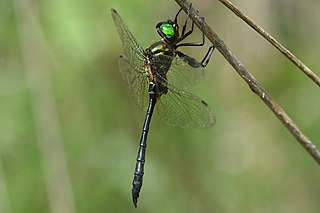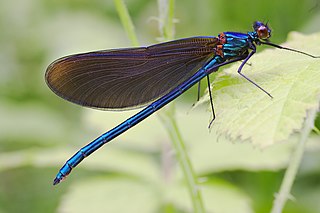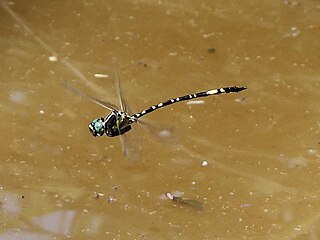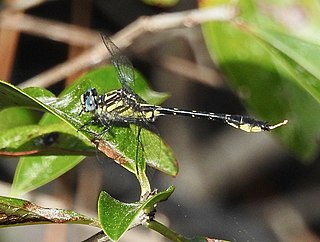
Odonata is an order of predatory flying insects that includes the dragonflies and damselflies. The two major groups are distinguished with dragonflies (Anisoptera) usually being bulkier with large compound eyes together and wings spread up or out at rest, while damselflies are usually more slender with eyes placed apart and wings folded together along body at rest. Adult odonates can land and perch, but rarely walk.

Damselflies are flying insects of the suborder Zygoptera in the order Odonata. They are similar to dragonflies but are usually smaller and have slimmer bodies. Most species fold the wings along the body when at rest, unlike dragonflies which hold the wings flat and away from the body. Damselflies have existed since the Late Jurassic, and are found on every continent except Antarctica.

Corduliidae, also knowns as the emeralds, emerald dragonflies, or green-eyed skimmers, is a family of dragonflies. These dragonflies are usually black or dark brown with areas of metallic green or yellow, and most of them have large, emerald-green eyes. The larvae are black, hairy-looking, and usually semiaquatic. This family include species called "baskettails", "emeralds", "sundragons", "shadowdragons", and "boghaunters". They are not uncommon and are found nearly worldwide, but some individual species are quite rare. Hine's emerald dragonfly, for example, is an endangered species in the United States.

Calopterygidae is a family of damselflies, in the suborder Zygoptera. They are commonly known as the broad-winged damselflies, demoiselles, or jewelwings. These rather large damselflies have wingspans of 50–80 mm, are often metallic-coloured, and can be differentiated from other damselflies by the broader connection between the wings and the body, as opposed to the abrupt narrowing seen in other damselfly families. The family contains some 150 species.

The Gomphidae are a family of dragonflies commonly referred to as clubtails or club-tailed dragonflies. The family contains about 90 genera and 900 species found across North and South America, Europe, Asia, Australia, and Africa. The name refers to the club-like widening of the end of the abdomen. However, this club is usually less pronounced in females and is entirely absent in some species.

Cordulegaster is a genus of dragonfly in the family Cordulegastridae. It contains the following species:

Macromia is a genus of large dragonflies in the family Macromiidae. Species of the genus Macromia are commonly known as river cruisers from their habit of cruising long distances along river banks. Most species occur in the tropical Australasian region, with one species being found in Europe , and a few species occurring in North America.

Ophiogomphus, commonly known as snaketails, is a genus of dragonflies in the family Gomphidae. Most of the species in the genus Ophiogomphus have beautifully marked green club-shaped abdomens, which are more noticeable in the males.

Phyllopetalia is a genus of dragonflies in the family Austropetaliidae. They are commonly known as redspots.

Gomphus is a genus of clubtail dragonflies in the family Gomphidae.

The Synthemistidae are the family of dragonflies commonly known as tigertails, or sometimes called southern emeralds. This family is part of the superfamily Libelluloidea.

Austrosynthemis is a monotypic genus of dragonfly in the family Synthemistidae. Its single species, Austrosynthemis cyanitincta, more commonly known as the turquoise tigertail, is found in south-western Australia, where it inhabits streams.

Lanthus is a genus of club-tailed dragonflies found in North America, commonly called pygmy clubtails. They are found in Japan and North America. The species are clear winged with black bodies and yellow markings.

Epiophlebia is a genus of damsel-dragonfly native to the Indian subcontinent, East Asia, and Southeast Asia. It is the only living genus of Odonata to neither be a dragonfly nor a damselfly. It is the sole member of the family Epiophlebiidae, which is itself the sole living representative of the infraorder Epiophlebioptera.

Eusynthemis is a genus of dragonflies in the family Synthemistidae. They are commonly known as tigertails. Species of this genus are found mostly in Australia with one species, Eusynthemis frontalis, found in the Solomon Islands.
Armagomphus is a monotypic genus of dragonflies in the family Gomphidae, endemic to south-western Australia. The single known species is small in size with black and yellow markings.

Armagomphus armiger is a species of dragonfly of the family Gomphidae, known as an armourtail. It is the only known species of the monotypic genus Armagomphus.

Archaeosynthemis is a genus of dragonflies in the family Synthemistidae. Species of Archaeosynthemis are found across southern Australia. They are medium-sized dragonflies with black and yellow markings.

Parasynthemis regina is a species of dragonfly in the family Synthemistidae, known as the royal tigertail. It is a medium to large and slender dragonfly with a long body and black and yellow markings. It inhabits stagnant pools and swamps in eastern Australia

Hylogomphus is a genus of clubtails in the family of dragonflies known as Gomphidae. There are about six described species in Hylogomphus.




















